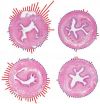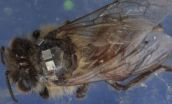(Press-News.org) Boston, Mass. - Sepsis, or bacterial infection of the bloodstream, is a grave, hard-to-diagnose threat in premature newborns in the NICU. Even when it's detected and treated with antibiotics, its inflammatory effects can harm fragile babies' development. Now, researchers at Boston Children's Hospital have modeled the effects of sepsis on the unique newborn immune system, using mice. They and others have begun using the model to identify diagnostic markers and better treatments.
The new model is described September 6 in the online open-access journal PLOS ONE (available after publication at: http://dx.plos.org/10.1371/journal.pone.0043897).
Premature infants typically are kept alive with catheters and intravenous lines that are vital for their care, but that also carry a risk of bloodstream infection, most commonly from the bacterium Staphylococcus epidermidis. Preventive measures can now avoid many of these infections, but those that slip through can be hard to spot and treat.
"When infection occurs, it's hard to detect in newborns, who can't speak and, due to their unique immune systems, tend not to have fevers or show clinical signs," explains Ofer Levy, MD, PhD, of the Division of Infectious Diseases at Boston Children's and senior author on the paper. "There may be irregular breathing or increased heart rate, or the baby may be acting a little 'off,' but these signs are pretty nonspecific. There's a tremendous need for better diagnostics in this field."
Mouse models of intravenous infections in newborns have been lacking, due to the technical challenge of working with tiny newborn mice. With great manual dexterity, Kenny Kronforst, MD, MPH, a clinical Newborn Medicine fellow working in Levy's lab and first author on the paper, was able to inject live S. epidermidis into the tiny animals' jugular veins, simulating what happens when an IV or catheter infection occurs in an hours-old preemie in the NICU.
The findings surprised the team—and gave hope.
"Newborns have traditionally been considered immunologically immature and distinct from adults in their ability to fight off infection," says Kronforst, now an attending physician in neonatology at Lurie Children's Hospital of Chicago. "Through our model, we have shown that there is a robust inflammatory response to bacterial challenge even at the earliest hours of life. Additionally, we were able to reproduce many clinical features of sepsis that we see in human infants. Because of these features, our model is ideal for exploring novel diagnostic and therapeutic possibilities—something we're extremely excited about."
For example, one part of the inflammatory response, also known to occur in human newborns, was increased production of a molecule called Toll-like receptor-2 (TLR2). Levy's team and others are now evaluating TLR2 as a potential biomarker for detecting sepsis, as well as a potential target for treatments to suppress the inflammation.
"We can now try to block TLR2 in our model, to see if we can clear bacteria faster and prevent inflammatory damage," Levy says.
Even when babies with sepsis are treated with antibiotics, the inflammatory response to the infection can be just as harmful. "Infants spend a lot of energy fighting the infection, and the inflammatory response impairs weight gain," says Levy.
Impaired weight gain was also seen in the mouse model. A separate study with the model, presented at last May's Pediatric Academic Society meeting, linked increased TLR2 production with another kind of damage: impaired development of the brain's white matter.
"There's an emerging literature showing that having bacteria in the bloodstream is harmful to the newborn brain, and that the inflammatory response harms the brain even if the infection is cleared," Levy says. "That raises the bar tremendously for detection and treatment."
Levy and his colleagues have been invited to apply for funding to develop new treatments using their mouse model.
INFORMATION:
The current study was supported by the National Institute of Allergy and Infectious Diseases (NIAID) and the National Institutes of Health. Coauthors were Christy J. Mancuso, MS, Matthew Pettengill, PhD, Jana Ninkovic PhD, Chad Stevens, MS, and Donald Goldmann, MD, all of the Division of Infectious Disease at Boston Children's Hospital; Melanie R. Power Coombs, PhD, Dalhousie University (Halifax, Nova Scotia); Michael Otto, PhD, NIAID; and Carina Mallard, PhD and Xiaoyang Wang, MD, PhD, University of Gothenburg, Gothenburg, Sweden.
Read about the Levy lab's related work on vaccines for newborns in our News Room and blog.
Boston Children's Hospital is home to the world's largest research enterprise based at a pediatric medical center, where its discoveries have benefited both children and adults since 1869. More than 1,100 scientists, including nine members of the National Academy of Sciences, 11 members of the Institute of Medicine and nine members of the Howard Hughes Medical Institute comprise Boston Children's research community. Founded as a 20-bed hospital for children, Boston Children's today is a 395 bed comprehensive center for pediatric and adolescent health care grounded in the values of excellence in patient care and sensitivity to the complex needs and diversity of children and families. Boston Children's also is the primary pediatric teaching affiliate of Harvard Medical School. For more information about research and clinical innovation at Boston Children's, visit: http://vectorblog.org/.
END
SALT LAKE CITY Sept. 6, 2012 - University of Utah engineers mapped white blood cells called eonsinophils and showed an existing diagnostic method may overlook an elusive digestive disorder that causes swelling in the esophagus and painful swallowing.
By pinpointing the location and density of eosinophils, which regulate allergy mechanisms in the immune system, these researchers suggest the disease eosinophilic esophagitis, or EoE, may be under- or misdiagnosed in patients using the current method, which is to take tissue samples (biopsies) with an endoscope.
These ...
SAN FRANCISCO, Sept. 6, 2012 -- After last year's accidental discovery of "zombie"-like bees infected with a fly parasite, SF State researchers are conducting an elaborate experiment to learn more about the plight of the honey bees.
The scientists are tagging infected bees with tiny radio trackers, and monitoring the bees' movements in and out of a specially designed hive on top of the Hensill Hall biology building on campus. At the same time, they are monitoring hives on campus and on the roof of the San Francisco Chronicle's offices for further signs of the mysterious ...
A protein called "clathrin," which is found in every human cell and plays a critical role in transporting materials within them, also plays a key role in cell division, according to new research at the University of California, San Francisco.
The discovery, featured on the cover of the Journal of Cell Biology in August, sheds light on the process of cell division and provides a new angle for understanding cancer. Without clathrin, cells divide erratically and unevenly—a phenomenon that is one of the hallmarks of the disease.
"Clathrin is doing more than we thought ...
A study carried out by Dr. Louis Bherer, PhD (Psychology), Laboratory Director and Researcher at the Institut universitaire de gériatrie de Montréal (IUGM), an institution affiliated with Université de Montréal, has shown that all seniors, even those considered frail, can enjoy the benefits of exercise in terms of their physical and cognitive faculties and quality of life and that these benefits appear after only three months.
This discovery is excellent news, as increased life expectancy has also increased the number of frail seniors in our communities. In geriatrics, ...
Untreated severe obstructive sleep apnea (OSA) is associated with an increased risk of cardiovascular mortality in the elderly, and adequate treatment with continuous positive airway pressure (CPAP) may significantly reduce this risk, according to a new study from researchers in Spain.
"Although the link between OSA and cardiovascular mortality is well established in younger patients, evidence on this relationship in the elderly has been conflicting," said lead author Miguel Ángel Martínez-García, MD, of La Fe University and Polytechnic Hospital in Valencia, Spain. "In ...
Cincinnati, OH, September 7, 2012 – Heart defects are the most common form of congenital malformations affecting newborns. Infants who were prenatally diagnosed with congenital heart disease (CHD) are more stable and have better outcomes than infants who were diagnosed after birth. Diagnosing CHD in a fetus also allows mothers to educate themselves on heart malformations, consider their options, and potentially plan for intervention or surgery after birth. However, a new study scheduled for publication in The Journal of Pediatrics finds that, along with these benefits, ...
Melanoma, newly diagnosed in more than 76,000 Americans in 2011, is the most common and dangerous form of skin cancer. Melanoma is rare in children, accounting for 1 to 4 percent of all melanoma cases and just 3 percent of pediatric cancers. Just as adult cases of melanoma are increasing, pediatric melanoma is rising at the rate of 1 to 4 percent per year.
The physicians and staff at Moffitt Cancer Center have a special interest in melanoma and related conditions occurring in childhood, and recently published results of their experience with cases of pathologically ...
Inflatables are a significant investment, both financially and for the livelihood of your business, and should be cared for as such. A few simple care and maintenance steps will keep your inflatables in tip-top form and damage free.
To prevent your inflatable from becoming a host for bacteria and germs you must clean and sanitize it thoroughly after each use. After an event, while the inflatable is still inflated, do a walk through removing any loose debris and trash. Once this has been picked up, sweep out the unit, the pillars and the netting.
After all of the ...
Sonoma Energy Capital, LLC. has successfully drilled the Maunie #2 Well to total depth in the N Maunie Field. The N Maunie field is a proven structure that has produced over 5 million barrels of oil from the formations above 3000 feet. " The Illinois basin is experiencing a modern oil boom and it is attracting oil producers from around the country ," according to Bob Nelson, President of Sonoma Energy Capital, LLC. "We are on the cutting edge of deep drilling in the Illinois Basin with our expert team". Sonoma Energy Capitals president, Bob Nelson, has ...
K2M, Inc., the largest privately held spinal device company in the world focused on developing innovative solutions for the treatment of complex spinal pathologies and minimally invasive procedures, today announced the launch of the SERENGETI Complex Spine Minimally Invasive Retractor System at the Scoliosis Research Society (SRS) 47th Annual Meeting in Chicago. SERENGETI Complex Spine brings K2M's focus on complex spine and minimally invasive together into one system by providing surgeons the ability to address deformity, trauma, and tumor, while promoting tissue preservation. ...


